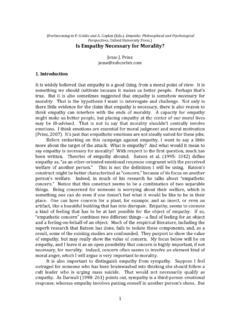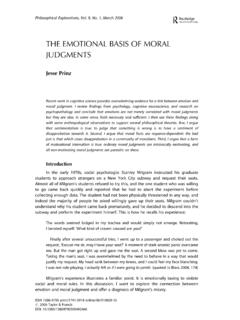Transcription of When is Film Art? - Jesse Prinz
1 1 when is film Art? (This is the written version of a talk at the Pacific APA, 2007, in Pasadena. Chris Grau was the commentator. Contact him for comments.) Jesse J. Prinz Introduction Intuitively, some films qualify as artworks and others do not. Few would deny that Un Chien Andalou qualifies as art, while many would feel little temptation to apply this honorific to the average Hollywood blockbuster, television melodrama, or sleazy porn flick. But what marks the boundary? when is film art? Some might restrict the label to avant garde cinema, European art house films, and video installations, while others are inclined to expand the category to include films intended for wide audiences, including Anthony Mann s noirs, Sergio Leone s westerns, and Mario Bava s masterworks of low-brow horror.
2 Some have even suggested that the art/non-art boundary does not exist. All film is art, though some of it is better art or higher art. How, if at all, should be draw the line? This, it turns out, is not just a question for those with a special interest in film . It has interest for aesthetic theory more broadly, because film can serve as a test case for definitions of art. Some theories of art seem too restrictive, because they prevent us from classifying certain films that are aesthetic masterpieces into the category of art. In what follows, I will first try to motivate an answer to the boundary question: when is film art? The theory I propose might be co-opted for use in answering the more general question when is anything art?
3 But I will leave that larger task to another occasion. 1. Inclusive and Restrictive Views Is All (or Most) film Art? In the early days of cinema, it was sometimes suggested that film is never art. film is, at best, a photographic record of an artistic performance, but not an artform in it s own right. This view, echoing similarly dismissive attitudes towards photography, was difficult to sustain. After all, film is much more that a recording. The camera is no innocent eye. Filmmakers need to make numerous choices about every shot, and, of course, film production involves editing, and editing typically results in a final product that is quite different from what an eyewitness to the filmed events would or could see.
4 These days it is hard to find anyone who would seriously defend the claim that film in never art. More typical is the opposite view that all or most film is art. According to this view, there is no principled way to draw the line between say L Avventura and Die Hard. The most visible recent defended of this view is Noel Carroll, whose book on Mass Art is an effort to raise popular entertainment media from their denigrated status. Carroll gives several arguments for concluding that films produced for mass consumption, including television sitcoms, quality as art. First, he notes that such films have genres and forms that are descended from genres and forms of works that are 2 uncontroversially considered works of art.
5 This gives such films prima-facie claim to art status, (1998: 196). Second, the creators of sitcoms and other popular works engage in activities characteristic of artistic practice: writing, acting, choice of shooting styles, and so on. Third, such words would count as art according to leading accounts of the nature of art. Carroll has in mind so-called classificatory approaches, which define art by appeal to how art works are identified as such, as apposed to more antiquated theories, like formalism, which define art by appeal to evaluative criteria. A fourth argument, implicit in Carroll and related to his third, is that those who deny art status to popular works are simply confusing the art/non-art distinction for some evaluative distinction, such as good-art/bad-art or high-art/low-art.
6 Popular works may tend to be less good than so-called art films, and they may lack high-brow or high-culture status, but that should not prevent them from being classified as artworks. Let me respond to these objections in turn. First, does descent from artistic forms and genres guarantee status as art? It would, of course, if forms and genres were sufficient conditions on being artworks, but this can hardly be assumed. Consider, for example, the genre comedy. The question, Are comedies always art? , seems to be as unsettled, as the question, Is film always art? Indeed, both questions are unsettled for similar reasons. All comedies clearly share certain things in common, but are those things sufficient for being artworks?
7 Carroll s first argument seems to beg the very question at issue. One can dramatize the point by showing that even when it is obvious that a traditional genre is being exploited, the question of whether the resulting product is a work of art can easily be addressed. For example, consider a comedic television commercial, a suspenseful re-enactment on America s Most Wanted, or a tragic soap opera. Are these artworks? Even highlighting the fact that these are comedies, suspense films, and tragedies does not resolve the question. And, to the extent that one is reluctant to extend the label art to such items gives us prima facie reason to think that falling into traditional genres or artforms is not a sufficient condition.
8 A similar response can be made to Carroll s second argument: the claim that most films are created by means of similar activities. Is the use of actors and the choice of camera angles sufficient for counting as an artwork? The answer is far from obvious, and it seems to be precisely what is under debate. It seems to follow from Carroll s argument that airplane safety films, infomercials, and various training films count as art. Perhaps that s an outcome we will be forced to accept, but Carroll s argument does not cut any ice, since someone who denies that all film is art will deny that any of these aspects of production are sufficient. Against this, Carroll will undoubtedly say, given all the similarities, it looks like mere fiat to stipulate that some films are art and others are not.
9 And, taken as an attempt to shift the burden of proof, his first two arguments have some weight. But, given that Carroll s taxonomy broadens the umbrella of art beyond where intuition normally takes us, that is evidence for the hypothesis that some tacit boundary is in place. It is not mere fiat to say that we, as a matter of fact, tend to draw a boundary somewhere. If one can explain how we do that, and if our intuitions are normatively defensible, then we will have reason to conclude that the boundary is real. Carroll s third argument states that most films satisfy the conditions laid out in prevailing classificatory theories of art. Unfortunately, he doesn t spell this out in detail.
10 On my reading of those theories, Carroll s claim in difficult to defend. Consider, briefly, three theories: Dickie s Institutional Theory, Levinson s Historical Theory, and Carroll s 3 own Narrative Theory. Dickie (**) says a work of art is an artifact of a kind created to be presented to artworld public. Now it should be obvious that many popular films are not created for the artworld, so, on the face of it, they do not seem to qualify as Next, consider Levinson s (**) Historical view, which can be roughly stated as follows: something is a work of art just in case is intended to be regarded in ways in which objects in the extension of artwork have previously been regarded. Here again, I think most films fail the test.












